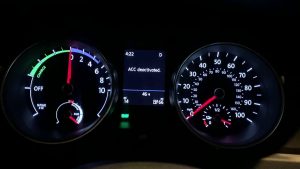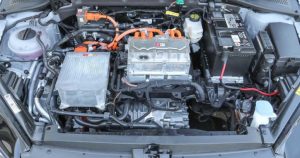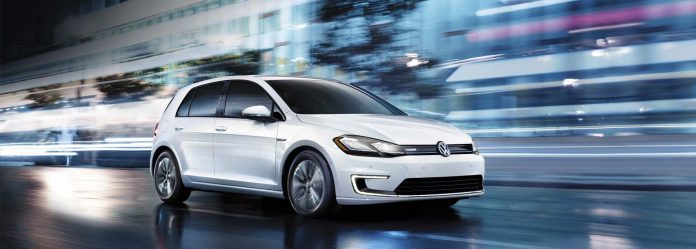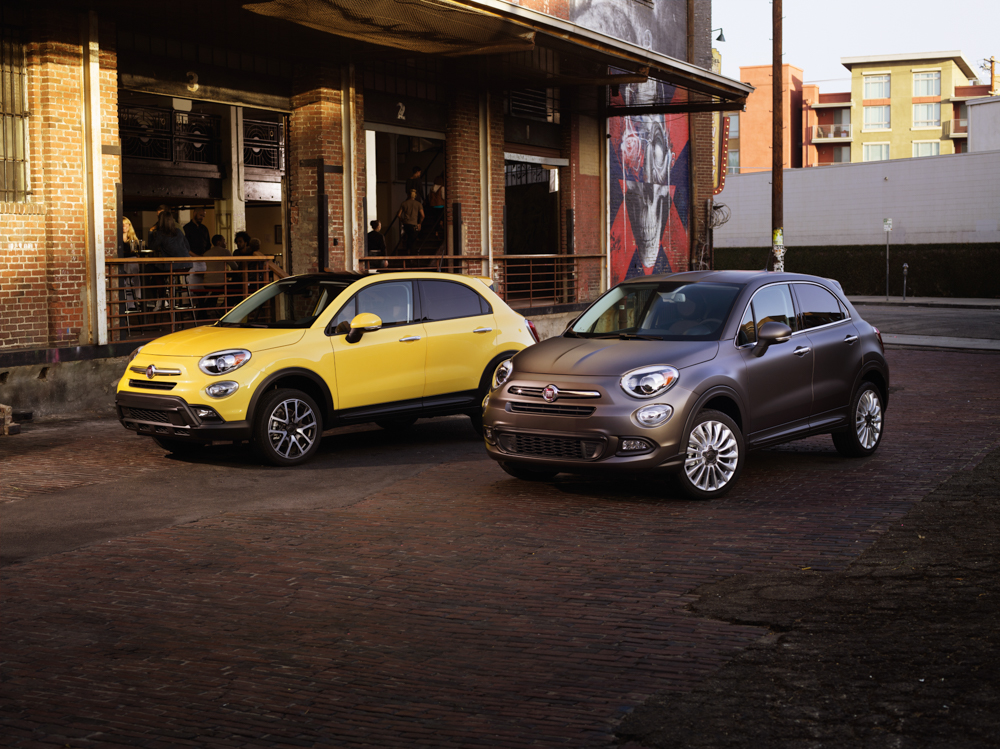I made it home – without a flatbed!
And without having to plug the eGolf in – and wait – before I could get home.
But the most interesting thing I discovered about VW’s first electric car wasn’t how far it can go, or how long it takes to recharge before you can get going again.
Drive an electric car and you will quickly discover it is not like driving a gas-engined car. Not just the immediate torque-pull of the direct drive electric motor under the hood – and not just the Stealth Mode silence of the thing.
There is another thing. A good – and bad – thing.
My round trip test loop was just under 70 miles – about 34 of them “down the mountain” to do a little work on my laptop at the coffee dive I frequent and then – remaining charge willing – back up the same mountain the same 34 miles, which I figured should be well within the eGolf’s remaining radius of action.
It was – but not by much.
When I got back home, the range indicator said I had 58 miles left.
This meant I had used up just a bit more than half (82 miles) of the eGolf’s indicated “full charge” range of 140 miles to travel 68 miles – so the range indicated when I began my trip was optimistic by about 10 percent.
That’s not unusual for any car. The EPA advertised mileage on every car has an asterisk/fine print attached: Your mileage may vary.
And usually does.
But what’s interesting is where the eGolf lost almost all of the 82 miles of range consumed during my 68 mile trip.
On the way downtown – literally down into town – the eGolf’s batteries not only didn’t grow weaker – they grew stronger. I enjoyed a free lunch at the Entropy Cafe.
The car rolled downhill – I used the Blue Ridge Parkway, a gorgeous drive – without expending any energy, while taking advantage of the inertia (via regenerative braking) to reverse entropy electricity back into its battery pack.
The eGolf’s range began to increase as we rolled.
By the time I was at the bottom of the mountain – after almost 15 miles of continuous downhill coasting from about 3,200 feet elevation to about 1,200 feet – the eGolf’s range display had notched up to 147 miles.
More than the supposed maximum full-charge range touted by VW.
No gas-engined car can match that feat – even with its engine turned off. And the AC won’t run with the engine off in most non-electric cars, being mechanically driven by the engine. You will also lose power steering and brakes – for the same reasons (usually; some IC cars now have electric power steering – but even so, with the ignition off, the power steering usually is, too).
Not the case here. I kept the AC cranking (and cold) as we rolled – the car silent as Omerta when that still meant something to the mob.
But the eGolf’s free lunch ended once I couldn’t mooch gravity.
By the time I rolled into the coffee shop parking lot – about another 10 miles of driving but no longer downhill and so requiring energy to keep the car rolling – the VW’s estimated range remaining was down to 117.
Still good, though.
In fact, better than good in that it only took a net 23 miles off the fully-charged 140 miles of range indicated at the start of my trip to make the approximately 34 mile drive from my place down to the coffee shop half-way/turnaround point.
On the other hand, it also works out to about 23 percent of the eGolf’s range – in gas engined terms, a quarter of a “tank” to go 34 miles.
The eGolf seems “thirstier” than it actually is because you start out out, effectively, with less than half a “tank” relative to what’s typical for most IC cars, including the non-electric Golf – which can go 300-400 miles on a tankful.
But I still had three quarters of a “tank” (117 miles of range) left at the mid-way point of my drive.
Or so I thought.
Going back up the mountain, the VW’s range remaining began to fall as dramatically as it had been rising on the way down.
It was like being in a Hellcat running 90 . . . with a leaking gas tank.
All the gains made coming down were lost going up.
It took 59 miles off the 117 miles of indicated range remaining at the halfway point to make it back up the mountain – equivalent to a loss of about 50 percent of its indicated range remaining.
The “needle” went from just a bit less than three-quarters “full” at the coffee shop to just over a quarter left (58 miles of range remaining) by the time I made it home.
If it used gas, the eGolf could rightly be called a hog.
A bigger “tank” – battery pack – would fix this perceptual and functional problem.
But that would definitely cost. And the eGolf is already pricey: $31,895 to start (vs. $21,845 to start for the same Golf but with a gas engine – and more than twice the range).
This same problem afflicts all the “affordable” electric cars – including the $30,000 Nissan Leaf (150 miles) and the $35,000 Tesla3 – which is no longer available for $35,000. Tesla just bumped the price up to about $39,000.
But you do get more than 150 miles of range now.
It’s an economic – and functional Catch 22.
For an electric car to be as all-around practical as an IC car, it needs to be able to go at least a couple of hundred miles on a charge – no matter how or where you drive.
Because of the time it takes to recharge.
It’s true some people will put up with waiting 30-45 minutes at a “fast” charger – or arrange their drive (and day) so as to recharge when convenient. Some people will also put up with the useless back seats of a high-performance sports car.
But most people just want to get going – and are used to being able to do that without an exorbitant wait or having to plan their day around it.
That means bigger/stronger batteries – and more money.
And that means fewer people can afford it.
The eGolf as it is costs $10k more than the standard (non-electric) Golf. How much more would it cost to give it a battery strong enough to go a solid 200 miles, whether uphill or downhill, before needing to plug in?
How much are people willing – and able – to pay for that?
It’s a question no one seems to want to ask, much less answer.
The eGolf is an interesting car. A neat car. It’s even a fun to drive car, god help me for saying so.
But it only has enough range to be realistically practical as a short-hop city/commuter car.
Which means the eGolf – like all currently available cars – is still a specialty car, just like a high-performance sports car or jacked-up 4×4. It has some real strengths – and some real weaknesses.
It’s not for everyone – and probably never will be, unless the cost comes way down or the range goes way up.
We’ll see.
…
Got a question about cars, Libertarian politics – or anything else? Click on the “ask Eric” link and send ’em in!
If you like what you’ve found here please consider supporting EPautos.
We depend on you to keep the wheels turning!
Our donate button is here.
If you prefer not to use PayPal, our mailing address is:
EPautos
721 Hummingbird Lane SE
Copper Hill, VA 24079
PS: Get an EPautos magnet (pictured below) in return for a $20 or more one-time donation or a $10 or more monthly recurring donation. (Please be sure to tell us you want a sticker – and also, provide an address, so we know where to mail the thing!)
My latest eBook is also available for your favorite price – free! Click here. 













An extra ten grand to divide the range of a Golf by a factor of 3….what a bargain. Worth noting is that the test described in this article is, absent the mountain, about optimal for electric cars in terms of temperature. We have this thing called “winter” in MN that reduces range by about a third. Combine that with charging wear & tear (about 500-1000 charging cycles per battery until it’s really no longer useful) reducing the useful range, and it sounds like a “great idea” whose time should never come.
Even better; the “old bug” rework with electric. Add 1000 lbs to an already overstressed frame and make a slow deathtrap into a fast one with very limited range. What’s not to like?
I’m a EE by training, so I should love hybrids and electrics, but the realities of lithium batteries (pretty much the best we’re going to get, really) temper my enthusiasm a lot.
Check out the second picture in this article.
https://www.zerohedge.com/economics/panic-spreads-georgia-carolinas-trump-warns-category-4-hurricane-dorian-very-hard-predict
Someone preparing their ICE for escape from the coming storm.
Anyone invent an electric Jerry Can yet?
Eric, When you started ‘down the mountain’ was the e-golf fully charged? Your range seemed a bit short. I am guessing that when you went down you did not get all the benefit of the regen’ because the battery was already full. This is another thing that the EV designers need to sort out. There should be some spare capacity at full charge to allow for an initial extra squirt if you live up a mountain. Without that, if you live up a mountain then only charge it to 90%, and see what is left when you get back. This reduces your electric bill a little.
I came across a variation of this when I was in China earlier this year. I went out in a Shanghai BYD electric Taxi. The driver had just started his day, and had a fully charged battery. BYD put bicycle brakes on this vehicle, and it needs regen to slow down quickly. So with a fully charged battery the driver kept burying his ankles into the floor boards. Luckily I had a Chinese speaking colleague who was able to persuade him to leave a much bigger gap to give us a better chance of surviving the journey. After the battery had discharged a bit the braking got a lot better.. but the driver didn’t.
Hi Electron,
Yup; of course we circle back to the beginning and the question: Why bother with all this Rube Goldberg nonsense? With an IC car, these issues disappear – you just drive. When you run low on gas, you fill up. In 5 minutes or less. Easy, convenient. None of this absurd monitoring of gauges and driving style to make it there and back.
An electric vehicle that does make sense.
https://www.asiatimes.com/2019/08/article/chinese-buses-are-magic-in-santiago/
Beijing’s subsidy cut is starting to hurt China’s largest electric car company
China’s latest electric-car subsidy policy is intended to strengthen the industry by “eliminating the inferior.”
https://qz.com/1683042/beijings-subsidy-cut-is-starting-to-its-largest-ev-maker-byd/
BYD makes ICEVs too. I’ve seen ’em in South America.
And another one
https://images.chinahighlights.com/allpicture/2018/03/6448c2cbfa2e4ed2bf16646b_cp_300x200.jpg
Hello Eric,
Not that I plan to buy one of these but you usually write more about a new car that you test.
Such as,
“What’s good”
“Under the hood”
“On the road”
“At the curb”, etc.
Should we just use a review of an IC VW for all the rest? Just wondering.
Hi Adam,
Full review is in the works… apologies for the delay. I have been running on seven cylinders for at least a week. My shoulder keeps me up all night and sleep deprivation does a number on my ability to write. Or even to keep the cats fed.
Hey Eric!
Man! You have this car for a few days, and you have to plan your life around the car, and it’s range/charging capabilities. Could you imagine living with it for YEARS?????????????! -And there are
peoplefools doing this already!!!This is the future of the First world….unless something drastic happens……
To think, that people are buying this crap up! (And that we’re being forced to subsidize it- just like we’re forced to subsidize wars and welfare and pigs- One knows one is truly a slave when one is forced to pay for those things which are completely antithetical to one’s own interests!)
Hi Nunz,
It really is demented. Dealing with this car – and trying to write about it – has paralyzed my brain for the past several days. I’ve agonized over what to write – and not just about the eGolf. I feel at loose ends. Ennui.
It is like trying to have a conversation with a carpenter ant; attempting to reason with him and get him to go chew on an old stump rather than my house….
Ahh…it’s all fun and games until you have to climb back up the mountain. In summer.
I used to live in VA, and reveled in my ’85 diesel silverado. Why, the thing got 25 MPG!
Until I was in the Blue Ridge, foot on the floor, smoking like a steamship, climbing the mountain at 30 MPH. Left the cruise control on too long and blew whatever momentum I had.
That said, with 2 x 20 gallon tanks, the thing would run forever. And in normal driving , it was awesome.
“By the time I rolled into the coffee shop parking lot – about another 10 miles of driving but no longer downhill and so requiring energy to keep the car rolling – the VW’s estimated range remaining was down to 117.
Still good, though.”
How is losing 30 miles of range to go 10 miles “good”
He means he didn’t have to walk.
Forget electric cars. Brace yourself for this: https://www.vox.com/2019/3/1/18241489/electric-batteries-aircraft-climate-change
Read the article and then went to the https://www.magnix.aero/ link.
On the front page – “All Electric. No Fuel. No Emissions. Less Noise.”
So two outright lies.
No Fuel? That electricity is coming from somewhere even if solar, hydro, wind or nuke. Those all cost shitloads of fuel and resources to manufacture.
No Emissions? We have covered that plenty of times here.
Funny how the e-folk forget all the emissions required to make their virtue-mobiles.
Even in the article they mention,
“The key limitation for aircraft is the energy density of its fuel: When space and weight are at a premium, you want to cram as much energy into as small a space as possible. Right now, some of the best lithium-ion batteries have a specific energy of 250 watt-hours per kilogram, which has already proved viable in cars. But to compete on air routes up to 600 nautical miles in a Boeing 737- or Airbus A320-size airliner, Schäfer estimated that a battery would need to have a specific energy of 800 watt-hours per kilogram. Jet fuel, by comparison, has a specific energy of 11,890 watt-hours per kilogram.”
So batteries only have to be around 50X better to match jet fuel. And only about 3X as good as today to be sort of viable. Sure, that sounds easy……….
These folks are insane.
Well, jet fuel may have 11,890 watt hours of chemical energy, but no jet engine uses it 100% effectively – state of the art is about 50%. Let’s call that 6,000 watt hours of propulsive energy in a kilogram of jet-A. Still 7x more than the 800 Wh battery.
These electric planes are tiny and slow, so it takes a lot less energy to move them through the air a certain distance. The A320 might take 2 hours to fly a distance the electric plane covers in four times the time.
I wish people compared similar things when making these pronouncements. When comparing energy of combustion engine, you have to look at total efficiency, not the energy content of the fuel. Electrics have very low battery capacity, but the efficiencies of converting that to motion are over 95%.
On the flip side, an electric two seat civil airplane might be possible to electrify with 800Wh/kg batteries, but don’t even think of comparing it to a jet. It would represent a massive step back in transport speed and range.
Sure.
Apples and Oranges here too in that these will not be electric jets but prop planes.
“The A320 might take 2 hours to fly a distance the electric plane covers in four times the time.”
And the issue of how much cargo is carried. If the e-plane can only carry say 10% the cargo of a jet, only 10 trips required to transport an equal load. I wonder how efficient that is?
“Right now, some of the best lithium-ion batteries have a specific energy of 250 watt-hours per kilogram, which has already proved viable in cars.”
Not sure whether to laugh, cry, or retch at this statement.
Every rechargeable battery I have ever owned seems to grow weaker over time and after fully charging them, they do not last as long as when newer. My 10 year old laptop battery may give me only 10-20 minutes of use where when it was new, 5-6 hours. So how will this battery strength deterioration work in an EV? Is there a noticeable degradation over 2, 3, or 5 years? The entire idea of EV’s has been suppositioned on the narrative of global warming destroying the earth. We have to cut down our carbon footprint and all that rubbish. With no carbon, the planet dies off anyway. Sure, someday the IC vehicle will be replaced, but EV’s ain’t it. And never for my dollar, even if Bernie or AOC gives them away.
This problem is well understood now, but it wasn’t in the past. LiPo battery life plummets quickly when you charge it to full, and drain it to empty. If you only ever charge it to 90% of full, and discharge it to 10% of empty, you’ll increase its life a hundredfold. Old electronics tried to use every last shred of capacity, at the cost of battery life. Newer electronics contain you to that 80% middle ground, which will make the battery last a tremendously long time. It’s also a function of charge and discharge rate. If you charge it in an hour, you wear it out faster than if you charge it over a few hours.
Apologies for being pedantic, but what you’re describing is not connected with the word “entropy”. Gravitational potential energy is in “useful” (i.e. recoverable) form. Entropy comes into play only when energy is converted to heat; after that, it’s pretty much unrecoverable. The caveat “pretty much” comes from the fact that if you have two bodies of heat at different temperatures, you can get some useful energy out while leaking heat from the hot into the cold reservoir.
You are of course absolutely correct to point out the deficiencies of electric vehicles, their nifty trick of turning gravitational potential energy into a battery charge notwithstanding.
Eric, are you saying that for my extra $10k in an eGolf I’d be screwed driving to my relatives in Idaho’s mountains during the winter, lights/heater/fan/radio running; or getting stuck in a snow bank here when it’s 30 below zero with a bracing 25 mph north wind blowing? By golly, I’ll buy one and let my green sympathy keep me warm.
Both my sons bought Leaf a couple yrs ago.. both drove them about 6 months… both got rid of them after 6 mo for the reasons in the article… short range, long recharge times and $$$. I tried to warn them b4 hand…
Hi Fred,
Yup. I find myself making excuses for the thing… like one might for a “special” kid…
I’ll take a Golf SE w/a 5spd and use the remainder to go st2 w/it (fmic, tune, downpipe, intake), new clutch and then head to Florida with the remainder
Ex and I drove from NM to Denver to Chattanooga back to Jersey, that SE she had was a gem, so why ruin a good thing with that EV crap?
The $10k premium to “upgrade” from the ICE to EV versions would buy almost 4,000 gallons of gas – well over 100k miles of driving. Maybe 200k to 300k miles of driving once you account for the cost of electricity. You’d never hit the break even point, since you’d have to buy new storage batteries well before then.
The eGolf isn’t even close to being cost-effective versus the ICE version.
The eGolf is 10k off MSRP right now. Then fed, state, and utility rebates are available. This will be cheaper than the gas model.
WOW I will buy 3 of the eGolf cars now
So, utilities are giving rebates for buying something which will cause one to use more electricity, and increase the demand on the electric grid? And yet they send around a paper every month in my bill, trying to bribe me with a whopping $20, to let them install a thing in my home that will allow them to reduce the juice at ‘peak demand times”…..
The West has truly gone insane!!!!!!!!!!!!!!!!!!!!!!!!
At least they gave you the option Nunzio!
I came home one eve and found the damn box bolted to my wall next to the AC.
Disconnected it immediately and then threatened with a vandalism charge..
I read a British report a while back which tested several electric cars and give or take a percent or so, the actual Range for EV’s is 85% of the advertised amount. Their stated Range for an E-Golf was 120 Miles.
My question is: What is Range? Is that full to empty? When I was in Autostadt, VW told me Yes. If this is true, who drives his car to empty? I usually go to a filling station when my tank is around 20% capacity. Does this mean, if I am driving an E-Golf as I would a gasoline or Diesel car, my Real World Range would be: 120 Miles less 20% or 96 Miles?
Hi Doug,
Range remaining is analogous to how many gallons are left in the tank of an IC-engined car – but with the very big difference than with an EV, you can’t just refuel and be back on the road in less than 5 minutes.
This means having to be much more conscious of range remaining – in order to avoid a long unplanned stop to recharge.
It also means less range after you recharge – unless you can wait until tomorrow. The “fast” chargers only instill about 80 percent, in order to avoid stressing the battery and reducing its long-term service life.
So, in the case of the eGolf, a “fast charge” would bring you back to about 112 miles (assuming a nearly discharged battery and just a few miles of range left when you plug it in at the “fast” charger).
Which would mean about 90 miles of actual range… and quite possibly less.
You see the problem…
Hi Eric,
Another difference that goes against an EV is that should you run out without any access to a charger, you’re only option may be to tow the damn thing. Running out of gas in an ICE is annoying, but it can usually be fixed without resorting to a tow truck. Carry a gas can, if close enough, walk to a gas station and fill it up, if not, hitchhike or call Uber, keep a bike in the bed of your truck, etc…
Most of the time, the consequences of running out of gas are not that significant; running out with an EV could really be a pain. Range anxiety is not just abut range, it’s also about the consequences of screwing up.
Cheers,
Jeremy
“should you run out without any access to a charger, you’re only option may be to tow the damn thing” Yep- you should always bring along a tow vehicle when driving an electric vehicle. Just in case.I wonder if your electric car was light enough, could you tow it behind a bicycle ? Or would you have to bring along a motorcycle large enough to tow your electric car ? And how much would that lower the range of your ‘car’ ? Questions, questions, questions. Maybe someone should ask the world’s smartest man- Barak Hussein Obama.
Here is a business I want to get into – tow trucks !! As more and more electric cars are mandated, the more tow-trucks and flat beds that will be needed!!!
Or even better – a generator on the back of a pickup. Can be called via an app for hipster millennials convenience.. Maybe even integrate into the Tesla UI. Charged per callout and usage time. And the generator will of course run on diesel (and for a bit of fun Ill have a manual choke on it so if the caller is too annoyingly self righteous, can just make the gen-set give of a ton of black smoke while he sits there watching it charge for over an hour!!)
Saw a picture of an electric car on the side of the road being charged from a trailer-mounted diesel generator being towed by a gas-powered minivan…
Awesome…
So, is this what your are saying?: The stated Range of an EV (whether it is a manufaturer’s claim or real-world situations) is bogus – that is, unless one expects to drive until his vehicle’s battery is dead and he can coast to a charger?
Eric don’t forget you got horrible range out of NEW batteries in the summer. you know as well as anyone else that batteries wear down a little every day throw in 10 below zero and that really shows how useless EC cars are
The range is also impacted by how low the batteries can be discharged, which will effect battery life. DJI, the drone manufacturer, recommends not discharging batteries below 30% for optimal battery life, although that can be set to whatever you wish. Tesla got some press out of opening up the range via over-the-air update when a hurricane evacuation order came down. Depending on what the VW engineers were trying to optimize the stated range might not really be the true “batteries be damned” range.
I could see where potentially a call to roadside assistance could allow for another few miles to get you to a safe location or charging station. Or people hacking the battery levels.
Funny thing about physics isn’t it? You cannot generate more than you use to return to the top, because there is always energy lost. Your machine would have to be more than 100% efficient to do so, which isn’t going to happen as long as we gave gravity, air resistance, and friction. Maybe some clever engineer or politician can get rid of those things, eh?
I got it ! Mount a bunch of small windmills on top of the car ! As the car goes down the road, the air would turn the windmills, generating electricity ! I should be a rocket scientist…er…I mean an aeronautical engineer…
gtc,
“Maybe some clever engineer or politician can get rid of those things, eh?”
The perpetual motion act of 2020?
I’m afraid the only thing that will exist in perpetuity is government.
Magnets ! Mount a large magnet on the electric car, and another larger one on your house. The one on your house should be an elecctro-magnet. When you get down the mountain, and want to get back home, use an app on your phone to turn on the electro-magnet at your house, pulling your electric car back toward your house. Of course, I know that it will not be enough to return the car by itself, but it could be enough of a boost to make up the difference between going down the mountain and going back up it. And don’t forget my idea about mounting the windmills on the car as well. It’s amazing to me that they won’t hire me as a scientist.
All those trucks with empty hitch receivers. Put ’em to use! It’s not fair that snowflake can’t get the same range as you in your F-250, so it’s only right that you have to tow “they” Tesla home. The handicapper general will be so pleased.
Repeal the Laws of Physics!
Make Thermodynamics Great Again!!!!
And this is when it’s brand spanking new….
Imagine 2 or 3 years down the e-road…before it
s even fully paid for, when the parts have worn and the battery’s capacity is diminishing???
Imagine when the owner goes to sell/trade it after a few years….with diminished battery capacity, and battery replacement looming, and discovers that his 30-something thousand dollar e-Golf-cart is only worth three grand……
It’d be like having an ICE car whose gas tank shrinks as time goes by…and which costs thousands to replace….
Nunzio I love the e golf cart statement that’s all it is an overhoromoned golf cart.
I’ve got the perfect slogan for them…..
“The 2019 VW eGolf. Specially designed for people whose lives are going downhill.”
No need to thank me, VW. You don’t even need to give me one of these cars……..really.
If you are only running downhill with an electric car, it may be a benefit with the battery initially less than fully loaded. The reason is that a fully charged battery can not store potential energy, because when fully charged, it will not accept any more charge, neither from a charger nor from the internal regenerating alternator. Thus, any loss in potential height energy will be fully lost as heat, and will not be regenerated and stored as usable energy in the batteries.
If it is possible to coast all the way downhill with the motor shut off, then an electric car should not start the trip with fully charged batteries.
…except for the “hotel loads” you’re not providing from the battery while regenerating. A/C or heat, lighting, like that.
I had a senile moment. The norwegian word for “charged” is “ladet” and I accidentally therefore translated with “loaded”, but I obviously meant “charged”.
I do not know how to edit comments to Eric’s articles.
Hey, don’t worry, Joney, it still makes sense- even saying “loaded”.
So, are the “plug-in hybrids” going away in favor of all electric? I have a guy at work who owns a Volt, with a ~50mile range on battery alone. Since he lives about 20 miles away, he can come back and forth to work on battery alone. He buys gas once a month, and even then it’s only a dozen gallons or so. He can road trip it, and then he’s on gas, making about 35mpg or so. He bought it used and got a great deal on it. That set up seems to make the most sense of all the “green” cars out there. Ha! Driving an electric car is kinda like riding a Harley Sportster with the peanut tank! It only has about 110 mile range! Guys with dressers hated when I was with them on their road trips…
Hi Tom,
The political problem with hybrids and plug-in hybrids is that they still have IC engines – which puts them in the crosshairs, regardless of their practical advantages (and more favorable economics vs. electric-only cars). It’s idiocy – because these cars “emit” essentially no harmful anything and – if regulatory standards were reasonable – would be knighted and sainted by the government. But the standards aren’t reasonable. They are political. Internal combustion-powered anything must go – no matter how impractical and expensive the alternatives are.
Another reason that automakers want to get rid of the ICE is that if they do, they no longer have to deal with the EPA and smog regulations at all. Imagine all of the cost savings- no designing and manufacture of emissions equipment, no emissions testing, no mufflers, no exhaust pipes, no catalytic converters, no fuel tanks, no cast-iron or aluminum engine blocks, no fuel injection systems or fuel pumps, no oil pumps, no oil to put in the engine, no gasoline or diesel fuel to put in the tanks, and much lighter vehicles to ship to their dealers. Not to mention all of the employees that design, manufacture, order, receive, and install all of these unneeded parts.
Hi Nathan,
This is absolutely true; not only can they save themselves a lot of money (and grief) they also know they can make more money by selling much-more-expensive electric cars.
A win for them; a loss for us.
Only if people buy them.
The guys with the pens backed up with the guns will take care of that.
Looking at your list, I wonder why electric cars cost so much more. Must be that battery thing: I suspect the fresh battery in my stick-shift truck would only drag it maybe a couple hundred yards before it failed.
Nathan: except that all the people who get their power from an electricity plant will now have to pay a lot more to upgrade the power plant, their emission controls, and the lines that distribute the power. The cost has only been transferred somewhere else.
yea but making batteries has to be one of the most toxic things to manufacture. the control freaks at the EPA will have a field day
Eric says:
“The political problem with hybrids and plug-in hybrids is that they still have IC engines – which puts them in the crosshairs, regardless of their practical advantages (and more favorable economics vs. electric-only cars). It’s idiocy – because these cars “emit” essentially no harmful anything and – if regulatory standards were reasonable – would be knighted and sainted by the government. But the standards aren’t reasonable. They are political. Internal combustion-powered anything must go – no matter how impractical and expensive the alternatives are.”
You are essentially correct but the real goal here is to remove any hint of individual autonomy from every human being on the planet. What the useful idiots do not understand, because none of them have any grasp of history, relates to after the revolution always comes starvation, genocide and absolute tyranny. The good news for me is that I’m on the tail end of an incredibly great life so the buffoons can not take that away and pointing that out tends to drive them up the wall….and because they have no sense (of humor), it’s quite easy to drive them to distraction. I refer now to the supporters of the authoritarian collectivists on both sides of the welfare/warfare state. The reason most of the authoritarian collectivists on the left have taken leave of the senses they never really had relates to the effectiveness of the propaganda they’ve been fed by the post-modernist progressive “education” system as opposed to the authoritarian collectivists on the right who have been fed a steady diet of old time religion. Anyway, this occurs with the backdrop of the collapse of Western civilization and perhaps the next Dark Ages from which humans may emerge in five hundred years with a healthy dose of skepticism….but I doubt it. There, doesn’t that make you feel all rosy with optimism? Enjoy what you can and your revenge against all the scumbags out there will be living on your own terms and thumbing your nose at their despair. P.S. – been reading Conceived in Liberty Volumes 1-4 Murray Rothbard….he had an interesting and fascinating take on the founding. Good stuff.
Good morning, Giuseppe!
Exactly so; well-said. The common denominator is this (sick) lust to control and it is now epidemic. It is a kind of elaboration of the Fuhrer Principle: everyone wants to order around the guy just below him on the hierarchy ladder; no one – just about – just wants to be left alone and to leave others alone, too.
Like you, I’ve been alive long enough to have savored some good times; and I’m old enough to remember better times. I’m ready, if it comes to what it may. I hope it won’t, but if it doesn’t, that would be an aberration.
Morning Eric,
If the trip was reversed you would have got better “mileage”. Starting by going downhill, you wouldn’t get much advantage because the “tank” was already full. Had you started by going uphill, it would have taken full advantage of the regenerative capability and added more to the “tank” on the way down.
Cheers,
Jeremy
Hi Jeremy, True… but I had to go down first in order to get back up!
Hi Eric,
Yeah, I just thought it’s an interesting difference between an ICE and an EV. Depending on your particular commute, this feature could make the car more or less practical.
Cheers,
Jeremy
You should plan your trip more carefully, so that your route is downhill both ways. Ask Barak Hussein Obama how to do it. He reversed the rising of the oceans, and he is probably not busy right now.
Dear Eric, on the other hand, you could choose for the coffee shop to be at the top of the hill, and your home where it once was, (liberals choose how things should be all the time, so should anyone else), then you’d always be fully charged, leaving for the coffee shop, and get the best value for your ev. LOL.
Very true, John!
My Trans-Am’s 455 shook me out of the coma I have been in the past three days on account of dealing with the verfluchte electric car..
Possible take it to the big city?,,, Stop and go through the reds and other traffic conditions normal to city driving would be interesting.
Wonder what the eco-nutz are going to do about all the trucks, local delivery, dump trucks, 18 wheeler’s etc? That’s where most of their alleged problems lie. I don’t see how they can go all electric without shutting down most if not all economic activity…
Except for the pricier IC cars many don’t have a range meter. My old 98 Regal does have this feature and the range in fact has exceeded the max range of the car while going down hill. And of course it drops dramatically going up hill like the electric.
What is the 12vdc (?) battery doing. One would think they would have power supplies to handle the lights and other low voltage equipment feeding off the main battery.
The dashboard information displays on most cars have a fuel economy page. They seem to work pretty well now. I think the old vacuum based gages were worthless. My Cherokee has a dedicated fuel economy page and it shows up on the trip computer too. There also a small range estimate that’s always there if you choose that on the primary display.
One thing I really didn’t like about the newer Honda Ridgeline was that the bezel around the display changes color in response to how lead footed you are. The salesman said it couldn’t be turned off. I might not have minded it so much if it turned green when you floor it and red when you brake, but of course that’s not how it worked. If I wanted to get nagged about my driving I’d get a wife, not a truck!
I had a ford mason dump in the 70’s and the vacuum fuel economy gauge worked perfect. if you were heavy on the pedal it went up if you eased off it went down and your speed stayed the same
That was a very fair and honest review. Given your normal comments about EVs, I wasn’t expecting that. I was expecting a more critical review of the E-Golf.
I agree though; in order to be practical, an EV has to offer at least 200 miles of range. The Nissan Leaf has a 200 mile version, but the problem is you have to get the top trim level and pay over $40k for it. If Nissan could keep the price to $30k while offering over 200 miles of range, I think the car would sell better. Compared to a century ago, EVs are a lot better, but they’re not ready for prime time yet.
Even Alejandro Agag, CEO and founder of Formula E, has said that in order for EVs to be adopted on a mass scale, the cars have to be better and their prices need to come down; IOW, they need to equal or surpass ICEVs, and he’s right. He started FE to foster improvements in EV tech. If you want a car problem solved, put racers to work on it! It’ll be interesting to see how EVs improve. I know that, over the course of the Gen I car (FE’s first four seasons), battery efficiency and range increased 14%. Mercedes and Porsche are joining the series next year, so the competition will go up even more. It’ll be interesting to see what the future brings…
I should send them my ideas about windmills and magnets. And I just had another idea that involves sails…Got to go.
but you have to realize that the 200 mile range when car is new starts to decline from the first day and does not stop. batteries wear out a little each day and once it get cols even a new cars range is severely hampered
Eric,
Been F5ing my keyboard to see the results of this. Better than I thought but not without some caveats.
I and lots others appreciate your unbiased by your own opinion/ expectation and adherence to scientific measurement to report on cars like the eGolf.
Keep up the good work and watch out for those clovers!
Well, you have now experienced range anxiety. Bet you got a little rush when you saw the driveway after your run.
This is a perfect demonstration of what these cars should be for: They can make a nice city car, secondary vehicles for running through suburbia, or for commuting if you’re under 50 miles round trip. If they could build such a vehicle, perhaps even one with that isn’t designed for highway travel, it might be a practical vehicle. But putting restrictions on vehicles like that isn’t going to be an easy sell. And of course someone is going to ignore the “no highway use” rule and take it out there anyway, so the first time there’s an incident it will blow up the media and soc-nets.
Amen, RK!
I hope this read fairly. I tried to explain some of the main pros and cons – without personal bias.
You made it back! Good deal.
Now you’ve got me curious. You gonna test the flat-land range with A/C going (since it’s summer in your neck of the woods now)? I’m wondering if the flat-land range is closer or farther from VW’s estimates. Ditto Interstate driving.
You recharging it with a 120V or 240V charger, out of curiosity again?
Hi Crusty!
Yes, I plan to give it a spin on the highway, at realistic highway speeds (70-75; any slower and you’re in danger of being run over).
I’d also like to separate out what it will cost to recharge this thing at my house. But the best I can do is await my next utility bill and see how much it went up vs.last month, to get a rough idea..
Not sure about the VW, but my Tesla X shows me the WH/mi for the last month (or any other time period I am interested in). My local utility charges me $0.11.4/KWH. Actually, my cost to charge is a little lower, since I charge late at night when the rate is lower. However, absent a separate electric meter for the cars, I just use my total KW to calculate the electricity cost. Result is my “X” costs a little under $.04/mi to operate. My Model 3 comes in a little under $03./mi.